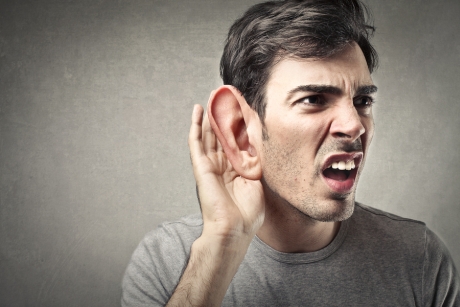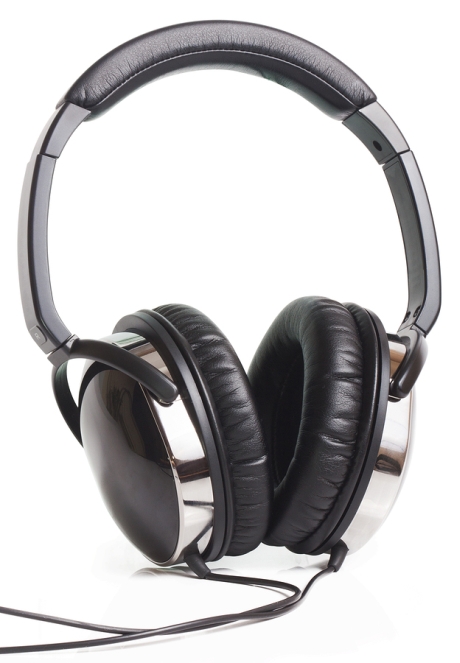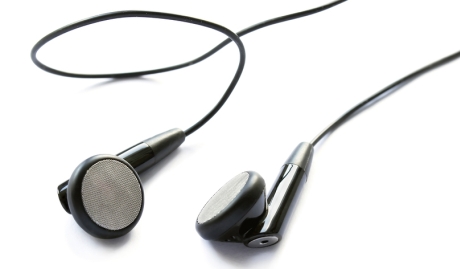By Robby
If you are new here please read this first.
Hi guys, whenever it comes to English listening, the typical picture most likely displayed is the following:

It’s the headphones I’m talking about!
Well, quite obviously there are other ways you can draw people’s attention to the fact that it’s the listening aspect that you want to focus on:

One way or another, but headphones are strongly associated with English listening practice and I don’t doubt for a second that you’ve used them at some stage in your English learning routine.
But here’s the thing. (Did you know you can say nearly everything using the word THING?)
When I had to sit my English exam in secondary school, nobody offered me to use the headphones.
When my daughter is doing her German homework, she doesn’t’ use her earphones – she just listens to the German audio lesson on her loudspeakers.
After all – when you listen to other English speakers speak in real life, there’s no headphones involved, and you have to be able to perceive the meaning of speech from a distance.
I mean – nobody is going to talk right into your ear, right?

As a matter of fact, they actually take it one step further during the listening part of exams, for example – they make it HARDER for you to distinguish the words and make out what the speaker is saying by adding some background noise the audio such as the sound of cars passing by…
You think it’s a good thing?
You think it’s going to improve your ability to understand?
It’s total NON-SENSE!
In reality, you’ll make huge improvements in your ability to understand if you make it EASIER for yourself to understand what’s being said.
Using subtitles is one way of making it easier for yourself to understand when watching films, for example.
But it’s not always an option, and furthermore –
It’s a good idea to teach yourself to understand English just by listening instead of reading, and that’s exactly when the headphones step in!
Before we move onto discussing the merits of using headphones though, let me just show you the difference between earphones, headphones and headsets – just in case you’re wondering whether they’re the same thing or not!
So, this is a typical set of headphones:

And here’s what earphones look like:

As far as headsets are concerned – this is what people mean when they mention it:

And no, it’s not me wearing the headset! 🙂
Here’s me:

Anyhow, going back to using the words “headset”, “headphones” and “earphones” – in real life these terms are sometimes used interchangeably. But now at least you have an idea of what exactly each of them represents!
So, now it’s about time we looked into the subject a bit deeper…
When Listening, Use All The Help You Can Get (IF You Need It)!
Before we look at the actual headphones, let me touch the topic of SUBTITLES.
Obviously, when listening to real people in real life, subtitles aren’t available… But wouldn’t it be cool if you could see the actual words coming out of peoples’ mouths when they speak?
That would be deadly! 😉

Anyway, it’s just fantasy and for now you can only enjoy subtitles when watching films on TV or on Netflix, for example (Netflix is my favorite – at the moment I’m watching Breaking Bad for the fourth or fifth time – I’ve lost the count by now!)
You can also switch the subtitles on when watching videos on YouTube, but in my experience they don’t work too well – the speech recognition technology isn’t so well developed yet as to pick up every single word correctly. Sometimes what the person says in the video and the text appearing at the bottom are totally different!
Anyway – the point is the following:
IF (mark this “IF” as very important!) you NEED some help with understanding when consuming English video content – by all means turn the subtitles on ❗
Don’t be thinking:
“Well, I don’t really understand what they’re saying because of the heavy accent/fast speech/whatever – but I’d rather not turn the subtitles on because I’ll learn to understand much better if I make it harder for myself…”
It’s as if you’re saying it’s easier to run when your legs are chained! 🙂

In reality nothing could be further from the truth – it’s only when you give yourself the chance to understand is when your listening experience is going to benefit you, so here’s a short list of things you can resort to when consuming audiovisual content in English:
- Subtitles – when watching films and TV programs,
- ESL videos with subtitles and audios with transcripts – there are plenty of videos and audio podcasts available for English learners that are transcribed (text provided in a form of an article below the video or audio) for better comprehension – here’s a GREAT website with plenty of them!
- Song lyrics – when listening to music in English.
Try to Wean Yourself Off the Subtitles!
It’s all nice and well – you’re using subtitles or a transcript as a means to help you understand the audiovisual English content and as a result you’re enjoying the process and you’re also improving your English listening comprehension.
But just like a baby that gets weaned off the mother’s milk and is made to eat ordinary food…

…you also should wean yourself off the subtitles and learn to understand English just by listening to it.
Why?
Well, the thing is that if you ALWAYS read while listening to English, it may contribute to your spoken English fluency issues!
What typically happens with us, foreigners, is that after all these years of traditional English studies our mind has developed something I like to call the “writing-mode” syndrome.
It’s when you’re trying to construct sentences in your mind while speaking just like as if you’re writing, and as you can imagine, having subtitles always displayed in front of you when consuming English video content can only reinforce this “writing-mode” syndrome! 🙁
So the basic problem is the following:
You have to SEPARATE written English from spoken English in all its forms!
Just like you should separate written English from your own speech in order to speak fluently, you also have to do it when listening to other people speaking.
Headphones – the IDEAL Tool to Help You Along the Way!
Here’s a funny thing – when watching Breaking Bad on my Android tablet, I used to have the subtitles on all the time.
Not that I care about it too much – if I need the subtitles, I’ll use them and I don’t CARE if some might say I should be able to understand the TV program without the subtitles.
I mean – what’s the point in watching the TV show if you struggle with understanding everything that’s being said, right?
Especially considering the fact that sometimes it’s the tiny little details that matter most – and they’re the ones you’re risking to miss!

So, just like I said – I used to have the subtitles on whenever I was watching my favorite TV show, but then one fine day I plugged the headset into my tablet and put it on because my wife was sound asleep next to me and I didn’t want to wake her.
Well – there was an alternative for me.
I could get outside and sit on the roof, for example…

…but I decided to go with the safer option of staying in bed and using the headset instead (yes, the same headset I’m using during Fluency Star coaching)
And guess what?
After a few minutes I realized that I DIDN’T NEED THE SUBTITLES anymore!
It was like some magic – just because I was listening to the TV program on my headset, all of a sudden I could understand every single word.
Magic?
Not really!
Here’s why it’s happening:
- Using headphones eliminates all other noises from the surrounding environment (very important!)
I hadn’t realized it up until I started watching Breaking Bad on my tablet that this is HUGELY important. I guess it’s one of those simple truths that are OBVIOUS but they just don’t register with you unless someone points them out to you. Just like the principle of you BEING what you DO, for example.
Now I can clearly see that when I use my tablet without the headphones, there’s always some other noises interfering with the TV program I’m watching, and it only stands to reason that eliminating those noises makes for better perception, isn’t that right?
But that’s not all!
- Using headphones creates the effect of you hearing everything INSIDE your head which really helps with understanding!
This is another HUGE factor helping with English listening comprehension! For some reason I can’t really explain, having the audio or video played inside your head does wonders to your ability to understand, and all of a sudden your brain finds its easier to read speech from the lips of the TV program characters, for example.
So the advice I have for you guys is the following:
Use headphones whenever possible when watching English videos, TV shows, films and indeed – when engaging in some specific English listening for learning purposes.
You may just find that using the headphones makes the entire listening experience so much easier and – most importantly – allows you to do away with using subtitles!
Any questions or comments?
You’re more than welcome to post them below ❗
Cheers,
Robby 😉
P.S. Would you like to find out why I’m highlighting some of the text in red? Read this article and you’ll learn why it’s so important to learn idiomatic expressions and how it will help you to improve your spoken English!
P.S.S. Are you serious about your spoken English improvement? Check out my English Harmony System HERE!
P.S. Are you serious about your spoken English improvement? Check out the English Harmony System HERE!


